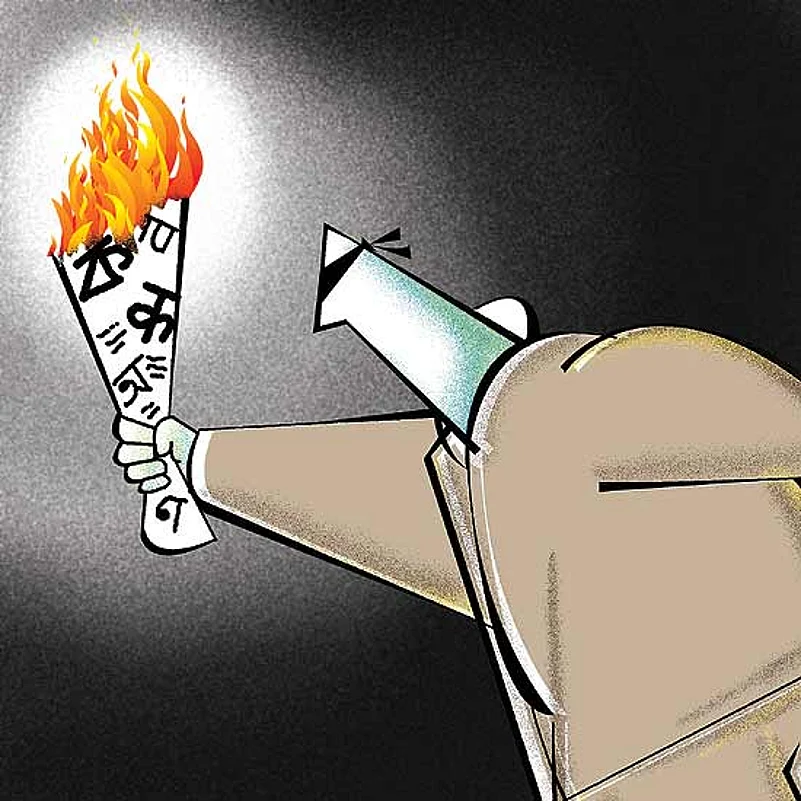What’s common to the Salman Rushdie episode, India’s dismal educational scenario—as underlined by the Programme for International Student Assessment (PISA) and Pratham’s 7th Annual Survey of Education Report (ASER)—and its appalling ranking on the Global Hunger Index (GHI)? It’s clear even on the surface: a deep disconnect between India’s claims on democratic superpower status and its grim reality. If you probe a little more, you might also understand the reasons behind this. Putting aside hunger for a moment, let’s look at India’s afflictions in the arena of knowledge and liberal values—the crux of enlightenment, the light of which is dim and flickering in India.
PISA, conducted every two years, ranked 15-year-old Indian students last but one in terms of reading, math and science abilities, just above Kyrgyzstan, in a worldwide test involving 73 countries. Pratham’s ASER says reading abilities of most Std V children in India are actually at Std II levels. Reading ability is the basic requirement for developing math and science abilities. But our elementary and secondary education, outside of some elitist and expensive islands, leaves the average student deficient even in basic reading. At the very foundation, we have fostered a society largely uncomfortable with reading, whatever our sham literacy statistics say. Isn’t this discomfort with reading, unaddressed at the school level, manifested in society in a deep impatience with reading and engaging with texts that are intellectually challenging and have layers of meaning beyond the most simplistic—such as Indian society’s discomfort with Rushdie’s The Satanic Verses or A.K. Ramanujan’s essay on our many Ramayanas? Extending that further, if we look at art as text in media other than the written or the spoken word—in fact, Sanskrit recognised this way of looking at art, and the verb ‘likh’ is used for both writing and painting—we also see the fear of subversion in the public’s response to challenges posed by art, whether of M.F. Husain or gay artist Balbir Krishan.
Our society’s discomfort with reading is so intense as to even threaten or beget violence. We aren’t making a simple connection between illiteracy and intolerance or bigotry, even though the vandals who hound a Rushdie or a Husain in mobs are often illiterate and would hardly even look at their work. What we are talking of is the quality of education or knowledge we foster in our society—after all, the rabble-rouser who ignites the first spark in the mob mind is at least superficially familiar enough with the work of the writer or artist to hate it sufficiently and incite hatred.
But the ruling establishment’s surrender before, or connivance with, this hate-mongering reflects a bigger malaise. Some people would attribute this to the exigencies of democracy and votebank politics, which is a necessary component of democracy. Some others might get into a facile discussion about the so-called soft state and hard state. But the pathology at the core of it is essentially one that is inherent to the species of ‘homo hierarchicus’, which has inhabited India for centuries. In keeping with this hierarchical culture, the educated elite that spawns and bankrolls a ruling class that serves its interests has successfully created a hierarchic educational structure, committed generally not to the pursuit of path-breaking knowledge, reason and enlightenment, but individual careerist goals, the way to which is paved with the easier options of focused imitation and learning by rote.
On the contrary, the enlightenment that real knowledge kindles should essentially illuminate universally. But that wouldn’t serve the goal of cornering the prize in a selfish rat race of dominance and status. Since real intellectual achievements require an overall climate for knowledge and exchange thereof, even our educated elite’s trace on the contemporary intellectual map of humankind is rather faint—a few exceptions apart. And isn’t it the same homo-hierarchical tendency that keeps most of our society hungry, malnourished and corners all the food, nutrition and wealth at the top?
There was a time when the educated class connected and communicated with society at large. The social and political reform movements of the late 19th and early 20th century are examples of this. The intellectual elite was not ‘elitist’, but an avant garde, a little ahead in thought, but communicating the thought to the wider society in its language or languages, as the case in India is. Post-independence, the trend continued for a while in the political realm, till politics, gradually divorced from the social arena, also acquired careerist colours, conniving, for power, with bigotry, narrowness and intolerance. As a result, the cultural capital of our society as a whole remains meagre.
















